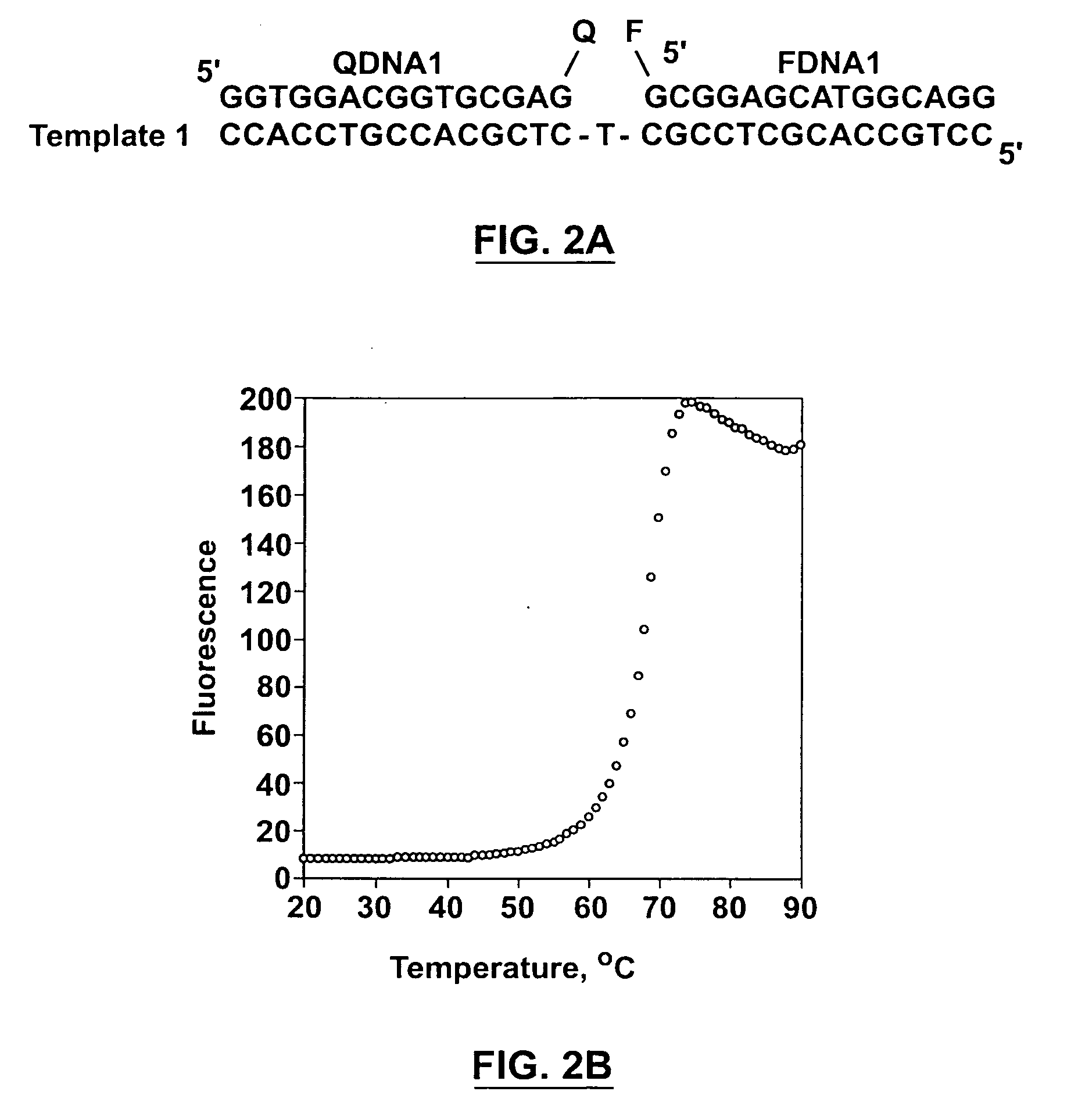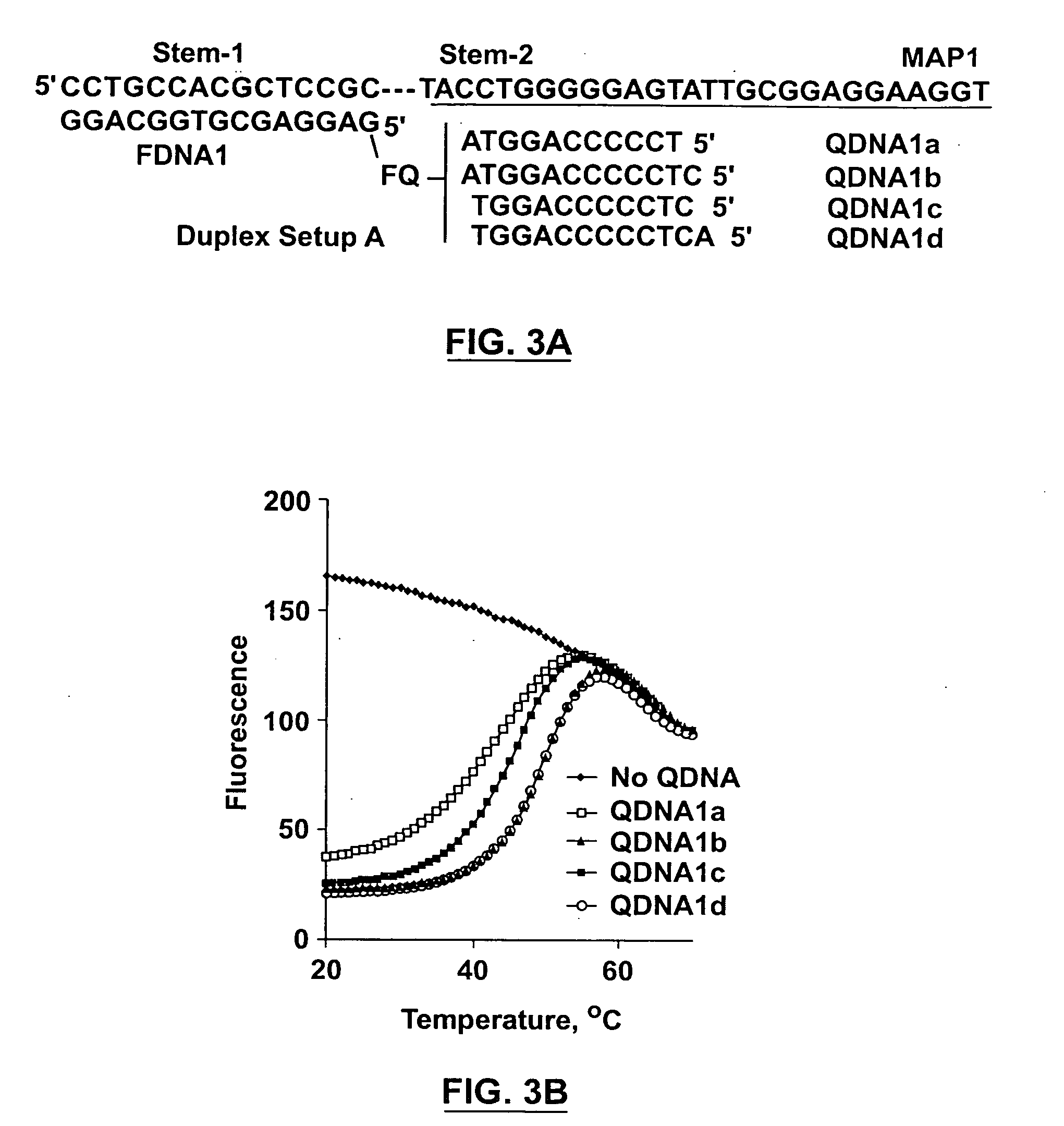Signalling aptamer complexes
a technology of aptamer complexes and aptamers, applied in the field of signalling aptamer complexes, can solve the problems of low sensitivity, incompatibility with small molecule detection, and lack of intrinsic fluorescence signaling ability of standard aptamers
- Summary
- Abstract
- Description
- Claims
- Application Information
AI Technical Summary
Benefits of technology
Problems solved by technology
Method used
Image
Examples
example 1
Oligonucleotides
[0101] Normal and modified oligonucleotides were all prepared by automated DNA synthesis using standard cyanoethylphosphoramidite chemistry (Keck Biotechnology Resource Laboratory, Yale University; Central Facility, McMaster University). Two kinds of modified oligonucleotides were prepared 5 that contained fluorescein and 4-(4-dimethylaminophenylazo)benzoic acid (DABCYL), respectively. Fluorescein and DABCYL were placed on the 5′ and 3′ ends of relevant oligonucleotides. 5′-fluorescein and 3′-DABCYL DNAs were synthesized by automated DNA synthesis with the use of 5′-fluorescein phosphoramidite and 3′-DABCYL-derivatized controlled pore glass (CPG) (Glen Research, Sterling, Va.). Unmodified DNA oligonucleotides were purified by 10% preparative denaturing (8 M urea) polyacrylamide gel electrophoresis (PAGE), followed by elution and ethanol precipitation. 5′-fluorescein or 3′-DABCYL modified oligonucleotides were purified by reverse phase high-pressure liquid chromatogr...
example 2
Fluorescence Measurements
[0102] The following concentrations were used for various oligonucleotides (if not otherwise specified): 40 nM for fluorophores (FDNAs), 80 nM for aptamers (MAPs), 120 nM for the quenchers (QDNAs). All measurements were made in 1500 NI solutions containing 500 mM NaCl, 3.5 mM MgCl2 and 10 mM Tris.HCl (pH 8.3). The fluorescence measurement was undertaken on a Cary Eclipse Fluorescence Spectrophotometer (Varian) and with excitation at 490 nm and emission at 520 nm. To obtain the thermal denaturation profile of a particular reaction mixture, the DNA solution was heated to 90° C. for 5 min, and the temperature was then decreased from 90° C. to 20° C. at a rate of 1° C. / min. A reading was made automatically for every 0.5° C. decrease.
example 3
Standardized Solutions
[0103] A general three-step procedure for measuring the fluorescence intensity of samples was developed. The procedure comprises the following steps: [0104] (1) Two 3× stock solutions were made and stored at −20° C., one of which (stock solution A) contained FDNA at 120 nM and MAP at 240 nM and the other (stock solution B) contained QDNA at 360 nM. The stock solutions also contained relevant metal ions and a buffer agent at desired concentration. [0105] (2) The sample to be measured for ATP concentration was made to contain the same metal ions and the buffer agent at the same concentrations as used for the above two stock solutions. [0106] (3) Stock solutions A and B were combined with the sample of interest at a ratio of 1:1:1. The resulting mixture was first incubated at 37° C. for 5 minutes and then let to stand at 22° C. for 10 minutes before its fluorescence was measured. The data obtained by the above procedure is highly reproducible with variation typic...
PUM
| Property | Measurement | Unit |
|---|---|---|
| pH | aaaaa | aaaaa |
| flow rate | aaaaa | aaaaa |
| pH | aaaaa | aaaaa |
Abstract
Description
Claims
Application Information
 Login to View More
Login to View More - R&D
- Intellectual Property
- Life Sciences
- Materials
- Tech Scout
- Unparalleled Data Quality
- Higher Quality Content
- 60% Fewer Hallucinations
Browse by: Latest US Patents, China's latest patents, Technical Efficacy Thesaurus, Application Domain, Technology Topic, Popular Technical Reports.
© 2025 PatSnap. All rights reserved.Legal|Privacy policy|Modern Slavery Act Transparency Statement|Sitemap|About US| Contact US: help@patsnap.com



